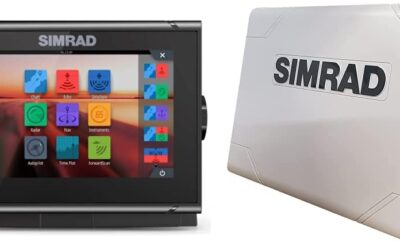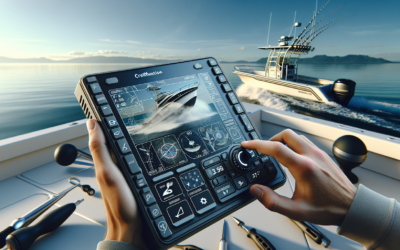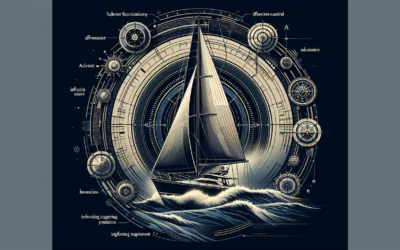Imagine yourself on a serene fishing trip, trusty fish finder in hand, ready to snag the biggest catch of the day. But what if you could enhance your experience even further? In this article, ‘Sonar Vs. Camera: The Benefits Of Using Underwater Cameras With Fish Finders’, you’ll discover how merging the old with the new, equipping your fish finder with an underwater camera, can completely transform your fishing exploits. Combining sonar technology with the crisp, clear visuals of a camera brings the underwater world straight to your boat, giving you the ultimate advantage in your angling adventures. So, let’s jump right in and explore this exciting innovation in fishing technology.
Understanding the Basics
You might have often heard about sonar technology, underwater cameras, and fish finders while exploring the domain of fishing or marine exploration. But what do these terms really mean? How do they impact your aquatic adventures? Let’s dive in!
Explanation of Sonar Technology
Sonar, which stands for Sound Navigation and Ranging, is a groundbreaking technology that uses sound waves to investigate and communicate underwater. It works by transmitting sound pulses and listening for the echoes when these pulses bounce off objects underwater. Sonar is most commonly used by submarines, divers, scientists, and of course, avid fishermen.
Understanding Underwater Cameras
Underwater cameras, as the name suggests, are specialized cameras designed to capture images and videos in underwater environments. They are encased in a waterproof housing to protect electronic components from water damage. These robust cameras can withstand high pressure and varying temperatures to give you a sneak peek into the vibrant world beneath the water’s surface.
What are Fish Finders?
Fish finders, often known as depth finders, are essential tools for marine travel, exploration, and fishing. They are specialized devices that use sonar technology to locate and display fish under water. Not restricted to just finding fish, these devices can provide valuable data regarding the water’s depth, temperature, and underwater structures.
How Sonar Works
Understanding how sonar works can truly deepen your appreciation for this innovative technology and its contributions to fishing and marine exploration.
Origins of Sonar
The concept of sonar dates back to the early 20th century, developed initially for military applications during World War I. Driven by the motive to detect enemy ships and submarines, it has since evolved and found its way into numerous civilian applications, including fishing.
Science Behind Sonar Technology
Sonar technology operates on the principle of sound waves. It works by sending out pulse of sound, often referred to as a ping, into the water. As this sound pulse travels, it eventually encounters an object and bounces back. The sonar device then calculates the time taken for the echo to return, providing valuable information about the object’s distance and size.
Practical Uses of Sonar in Fishing
In the context of fishing, sonar equips you with key insights that can maximize your catch. It helps in determining the presence, location, and size of a school of fish. Additionally, fish finders that utilize sonar provide details about the water depth, temperature, and contours of the sea or lake bed, painting a clear picture of the aquatic environment.
Benefits of Using Sonar
Sonar technology offers numerous benefits, particularly enhancing the fishing experience and productivity in several ways.
Accuracy in Detecting Fish
One of the prime advantages of using sonar is the precision it offers in detecting the presence of fish. The technology can identify fish school locations accurately, thereby increasing the success rate of your fishing expeditions.
Ability to Map Underwater Terrain
Sonar technology allows you to map the underwater terrain effectively. It provides data about the shape and structure of the seafloor, revealing the presence of potential fish habitats like underwater ledges, rock formations, and plant life.
Functionality in Deep Water
Sonar functions exceptionally well in deep waters, where light penetration is minimal and visibility is poor. It enables the detection of structures and fish at profound depths that would be otherwise inaccessible.
Reliability in Turbulent Waters
Even in turbulent waters with constant motion, the performance of sonar technology remains reliable. It can consistently provide accurate information, contrary to visual methods that may get disrupted due to waves and currents.
Drawbacks of Sonar Use
While sonar technology is indeed advantageous, it does come with a few limitations.
Difficulty in Differentiating Species
One significant drawback of sonar is that it can’t differentiate between fish species. It displays all fish as similar icons or arches, leaving you to guess the specific species lurking beneath your boat.
Misinterpretation of Data
The data from sonar can sometimes be complex and challenging to interpret. Differences in water conditions, temperature, or salinity may alter the sonar readings, which can lead to misinterpretation if not understood properly.
Potential Impact on Marine Life
While sonar’s impact on marine life remains a topic of ongoing research, some studies indicate potential disturbances to marine animals, specifically those that rely on sound for communication, such as dolphins and whales.
Understanding Underwater Cameras
Let’s delve deeper into understanding underwater cameras and their role in marine exploration and fishing.
Origins of Underwater Cameras
Underwater cameras have been around since the late 19th century, starting with simple box-like housings to protect the camera from water. Over the years, they evolved radically and encompass digital and action cameras, ROVs, remotely operated vehicles, and advanced professional-grade systems.
How Underwater Cameras Work
Underwater cameras function similarly to regular cameras, with the key difference being their design to endure the harsh underwater environment. They consist of a robust waterproof housing that protects the camera allowing it to capture images and videos under the water without any water seepage into the device.
Practical Uses in Fishing
For the fishing enthusiast, underwater cameras can make a big difference. They offer real-time visual feedback of the world beneath, enabling you to view the size, species, and behavior of the fish. They can help in locating fish, observing bait, and understanding how fish respond to your lures.
Advantages of Using Underwater Cameras
The use of underwater cameras comes with an array of advantages.
Visual Confirmation of Species
Unlike sonar, underwater cameras can provide visual confirmation of fish species. By looking at the captured images or video footage, you can easily determine the type of fish present.
Study of Fish Behaviour
Through observation of live footage or examining recorded material, underwater cameras allow you to study fish behaviour closely, which can be beneficial in developing effective fishing strategies.
Exploration of the Underwater Environment
Underwater cameras empower you to explore the underwater environment. They can reveal fascinating insights into the marine ecosystem, various aquatic species, and beautiful seascapes that you otherwise wouldn’t be able to witness.
Limitations of Underwater Cameras
Despite their numerous benefits, it’s important to acknowledge certain limitations with underwater cameras.
Limited Range
Underwater cameras typically have a limited range. They can only capture what is within their field of view, making large area surveillance or fish detection a challenge.
Dependence on Lighting and Visibility
The performance of underwater cameras is heavily dependent on lighting and visibility conditions. In deep waters where light levels are low or in murky waters with high turbidity, the camera might not produce clear images.
Issues with Turbulence
Turbulent waters can affect the stability of the camera, leading to shaky, unclear footage. Floating debris in the water could also risk damaging the lens or the camera housing.
Integration of Underwater Cameras with Fish Finders
Integration of underwater cameras with fish finders presents a comprehensive solution, melding the strengths of both sonar and visual technology.
Purpose of Integration
The primary purpose of this integration is to maximize the information available to the user. While fish finders excel at locating fish and mapping underwater structures, underwater cameras can provide the visual evidence of the species and their behavior.
How the Integration Works
In this integration, the fish finder uses sonar to locate fish and depict the undersea terrain. Meanwhile, the underwater camera delivers live video footage or images, providing visual validation of the findings of the fish finder. The two devices can work in tandem to improve your fishing experience significantly.
Potential Outcomes of Integration
By supplementing the fish finder’s sonar data with visual confirmation from underwater cameras, you gain thorough insights into the underwater environment. This combination can not only increase your chances of a successful catch but also enrich your fishing experience by enhancing your understanding of marine life.
Benefits of Using Underwater Cameras With Fish Finders
There are numerous benefits associated with using underwater cameras in combination with fish finders.
Enhanced Fish Detection
By combining the range and detailing of sonar with the visual feedback of cameras, you enhance your ability to detect fish. It gives you a broad and detailed view of what lies beneath the water surface, increasing your chances of a successful catch.
More Accurate Species Identification
With the visual input from the underwater camera, you can identify the species of fish more accurately. It moves beyond the generic sonar arches and fish icons to give you a real look at the fish under the water.
Better Understanding of Underwater Environment
The integration of fish finders and underwater cameras provides a comprehensive view of the underwater environment. It offers a deeper understanding of the sea or lake bed terrain, fish habitats, and various other elements of the aquatic world.
Improved Fishing Experience
Ultimately, this integration results in an improved fishing experience. It empowers you to make more informed decisions, derive substantiated insights, and enjoy the visually captivating world that lies beneath the water’s surface.
Future Trends in Underwater Imaging and Fish Detection
The field of underwater imaging and fish detection is brimming with transformative potential, promising to redefine how we explore and interact with the marine life.
Emerging Technologies in Underwater Vision
With advancements in digital imaging, sensor technology, and AI, the capabilities of underwater cameras are set to increase dramatically. We can look forward to more detailed, high-definition imaging, better low-light performance, and greater range and autonomy in underwater cameras.
Impact of AI on Fish Finders
Artificial Intelligence (AI) promises to make fish finders smarter. Techniques such as machine learning and data analytics can be used to interpret sonar signals more accurately, differentiate between fish species, and even predict fish behavior based on historical data.
Integration of Sonar, Camera and AI
The integration of sonar, camera, and AI can revolutionize the field of fish detection. It can provide real-time, detailed analysis of the underwater environment, automate the detection and identification of fish species, and even personalize fish-finding strategies based on individual preferences and historical data.
Potential Future Developments
These advancements could pave the way for more intuitive, fully integrated marine exploration systems. We might see the development of underwater drones equipped with sonar, HD cameras, and AI that perform automated exploration and data collection, becoming valuable tools for fishing, marine science, and underwater photography.
To sum up, both sonar technology and underwater cameras play a crucial role in fishing and marine exploration. They each have their strengths and limitations. However, by integrating the two, and potentially incorporating AI in the future, we can look forward to ushering in a new era of underwater exploration that is more accurate, insightful, and engaging.









